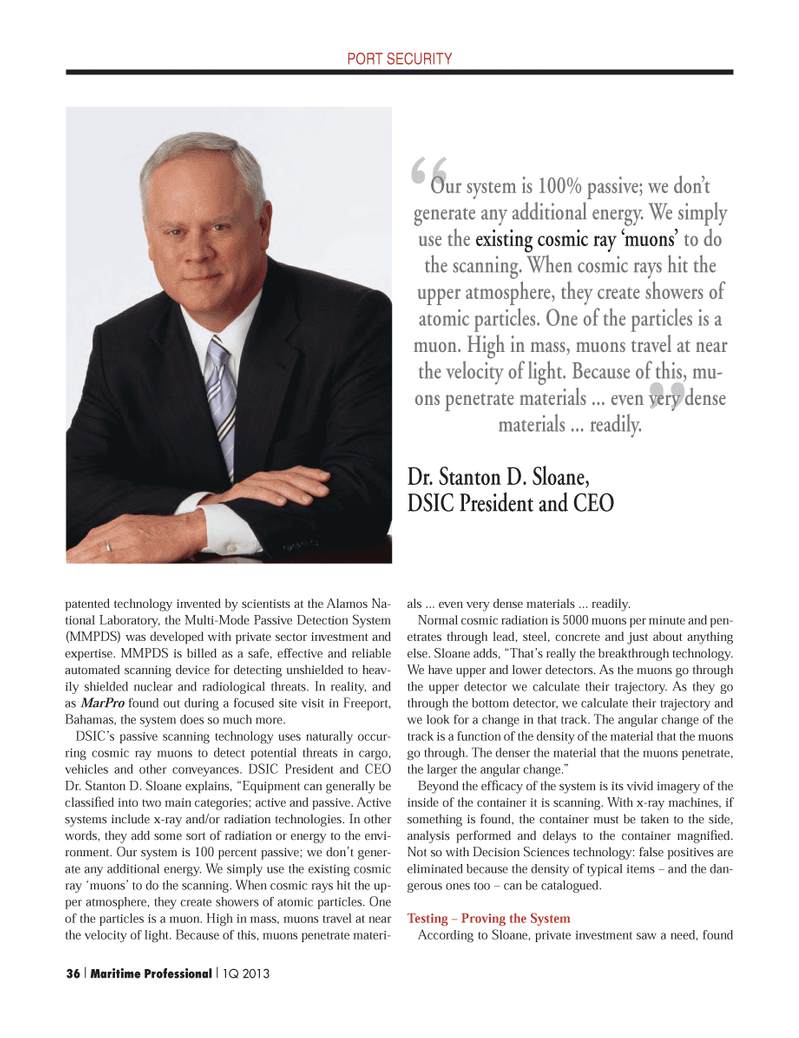
Page 36: of Maritime Logistics Professional Magazine (Q1 2013)
Maritime Risk
Read this page in Pdf, Flash or Html5 edition of Q1 2013 Maritime Logistics Professional Magazine
patented technology invented by scientists at the Alamos Na- tional Laboratory, the Multi-Mode Passive Detection System (MMPDS) was developed with private sector investment and expertise. MMPDS is billed as a safe, effective and reliable automated scanning device for detecting unshielded to heav- ily shielded nuclear and radiological threats. In reality, and as MarPro found out during a focused site visit in Freeport, Bahamas, the system does so much more.DSIC?s passive scanning technology uses naturally occur- ring cosmic ray muons to detect potential threats in cargo, vehicles and other conveyances. DSIC President and CEO Dr. Stanton D. Sloane explains, ?Equipment can generally be classi ed into two main categories; active and passive. Active systems include x-ray and/or radiation technologies. In other words, they add some sort of radiation or energy to the envi- ronment. Our system is 100 percent passive; we don?t gener- ate any additional energy. We simply use the existing cosmic ray ?muons? to do the scanning. When cosmic rays hit the up- per atmosphere, they create showers of atomic particles. One of the particles is a muon. High in mass, muons travel at near the velocity of light. Because of this, muons penetrate materi- als ... even very dense materials ... readily. Normal cosmic radiation is 5000 muons per minute and pen-etrates through lead, steel, concrete and just about anything else. Sloane adds, ?That?s really the breakthrough technology. We have upper and lower detectors. As the muons go through the upper detector we calculate their trajectory. As they go through the bottom detector, we calculate their trajectory and we look for a change in that track. The angular change of the track is a function of the density of the material that the muons go through. The denser the material that the muons penetrate, the larger the angular change.? Beyond the ef cacy of the system is its vivid imagery of the inside of the container it is scanning. With x-ray machines, if something is found, the container must be taken to the side, analysis performed and delays to the container magni ed. Not so with Decision Sciences technology: false positives are eliminated because the density of typical items ? and the dan-gerous ones too ? can be catalogued.Testing ? Proving the System According to Sloane, private investment saw a need, found PORT SECURITY ??Our system is 100% passive; we don?t generate any additional energy. We simply use the existing cosmic ray ?muons? to do the scanning. When cosmic rays hit the upper atmosphere, they create showers of atomic particles. One of the particles is a muon. High in mass, muons travel at near the velocity of light. Because of this, mu- ons penetrate materials ... even very dense materials ... readily. Dr. Stanton D. Sloane, DSIC President and CEO 36 I Maritime Professional I 1Q 2013MP #1 34-49.indd 36MP #1 34-49.indd 362/22/2013 11:17:41 AM2/22/2013 11:17:41 AM

 35
35

 37
37
